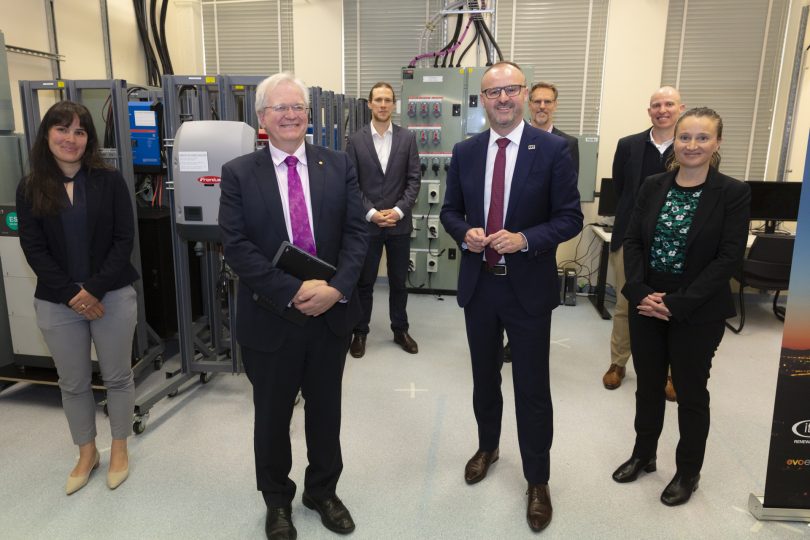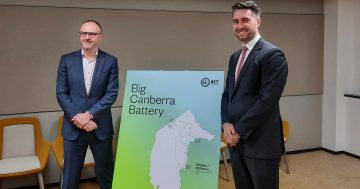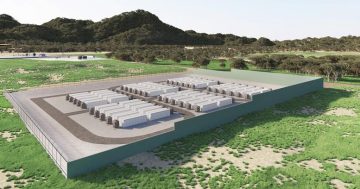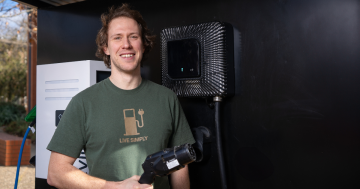
ANU Vice-Chancellor Professor Brian Schmidt (second from left), ACT Chief Minister Andrew Barr (fourth from left); and Battery Storage and Grid Integration Program chief operating officer Heather Logie (right), with other members of the Distributed Energy Resources Lab team. Photo: Thomas Lucraft.
Research from a new renewable energy laboratory at the ANU will help drive redesign of the ACT’s decarbonised electricity system so it will be stable and reliable.
ACT Chief Minister Andrew Barr, who opened the Distributed Energy Resources (DER) Lab on Tuesday, 13 July, 2021, said the research, development and innovation from this facility could be applied in the ACT ‘s energy network, across Australia and globally.
Mr Barr said government investment decisions, such as its Big Battery project, would be based in large part on the output from labs such as this.
“[The ACT Government is] getting the best possible advice on new and emerging technology and different ways to deliver our ultimate outcomes for energy network stability, reliability and affordability, and charging our way towards a zero-emissions future for this city,” he said.
“We very much look forward to it contributing not only our investment and policy decisions at a Territory level, but feeding through into decisions taken within the national electricity market [by] larger state governments, and one would hope [it] might inform Federal Government energy policy.”
The ACT Government has injected $1.5 million into the project which has been underway for two years, and whose partners include ITP Renewables, UNSW Canberra and Evoenergy.
The DER Lab is set up to test ways to establish a stable, reliable and cheaper electricity supply from renewable energy sources in a decentralised system where devices such as batteries, vehicles and even air-conditioners play a role.
Heather Logie, chief operating officer of the Battery Storage and Grid Integration Program, said the DER Lab, which has its own solar photovoltaic (PV) panels, contained a ‘plug and play’ replica electricity network that would allow researchers to build, test and validate new systems, devices and capabilities.

Heather Logie: “We have a unique opportunity in the ACT to demonstrate the pathway to mass electrification of the economy without compromising on economic growth.” Photo: Thomas Lucraft.
One such project is the trial of bidirectional electric vehicles that can feed energy back into the grid to stabilise it when needed.
Ms Logie said the electricity system is moving away from a centralised system based on large fossil fuel generators to one that is distributed, decarbonised and digitised.
“We have a unique opportunity in the ACT to demonstrate the pathway to mass electrification of the economy without compromising on economic growth,” she said.
“Then show the rest of the world how to do it.”
It is envisaged other universities, startups and industry will also use the DER Lab, which can be accessed remotely.
“We have some incredible equipment here that allows us to do simulated scenarios in the lab,” said Ms Logie.
This means things could be tested to their limit or simulating extreme events such as bushfires and heatwaves that put electricity systems under pressure, she said.
ANU Vice-Chancellor Professor Brian Schmidt said the DER Lab will help drive Australia towards a low-emissions society.
He said transforming the electricity system is a vital first step to lessening the impacts of climate change and extreme weather events by ultimately lowering the trajectory of CO2 in the atmosphere.
“Research in this lab will help us be equipped to smooth out and accelerate the energy transition,” said Professor Schmidt.
He said the DER Lab will provide a failsafe power system to rapidly, effectively and securely test the technologies and systems before they go out to the consumer.
The challenge was to get all the different parts of this new energy system to work together.
“Australia is a distributed energy resources superpower,” said Professor Schmidt.
“We have an opportunity to not just cope, but be leading and economically benefit in ways other countries simply will not.”
Mr Barr said it is frustrating that national energy policy isn’t more supportive of, and more conducive to, innovation and transition, and that the private sector does not have the certainty it needs.
“But sometimes small governments can run fast and achieve some really great things,” he said. “This one is a really good example of that.”
Professor Schmidt said the world will ultimately impose its views on Australia one way or another.
“We are not going to be able to go it alone,” he said. “We’re going to need to have the technology, what you see here, to decarbonise our economy,” he said.
“We have the opportunity to do that better and cheaper than literally any other developed economy in the world.
“That means we’re going to have access to the cheapest renewable electricity in the word. That creates an opportunity for all sorts of industry that will help Australia be prosperous in the decades to come, and that is why we are acting now.
“We are getting out in front of the curve so when the opportunities arise in the years and decades ahead, we already have the people, the technology and the capability to go forward.”
















